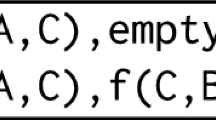Abstract
Mechanical theorem provers are becoming increasingly more powerful, and we believe that it is time to examine whether certain tasks that have formerly been accomplished by other means can now be performed efficiently by a theorem prover. One such task is classification in description logic-based knowledge representation systems. Description logic systems provide a formalism for expressing knowledge based on concepts and roles. Subsumption checking is one important reasoning faculty offered by such systems. In this article we use a theorem prover coupled with a finite-model finder to perform subsumption checking. This approach is complete and sound for description logic systems whose underlying logic has the finite model property. The performance is compared with several other well-known description logic systems. Some efficient strategies to compute the subsumption hierarchy, known as classification, are also described.
Similar content being viewed by others
References
Buchheit, M., Donini, F. M. and Schaerf, A.: Decidable reasoning in terminological knowledge representation systems, J. Artificial Intelligence Research 1 (1993), 109–138.
Baader, F. and Hollunder, B.: KRIS: Knowledge representation and inference system, SIGART Bulletin 2 (1991), 22–27.
Baader, F., Hollunder, B., Nebel, B., Profitlich, H-J. and Franconi, E.: An empirical analysis of optimization techniques for terminological representation systems, In Principles of Knowledge Representation and Reasoning – Proceedings of the 3rd International Conference, 1992.
Borgida, A. and Patel-Schneider, P. F.: A semantics and complete algorithm for subsumption in the classic description logic, J. Artificial Intelligence Research 1 (1994), 277–308.
Brachman, R. J. and Schmolze, J. G.: An overview of the KL-ONE knowledge representation system, Cognitive Science 9 (1985), 171–216.
Chu, H.: CLIN-S User's Manual, 1994.
Chu, H. and Plaisted, D.: Generating unit consequences of a ground clause set, Technical report, University of North Carolina, Chapel Hill, N.C., 1992.
Chu, H. and Plaisted, D. A.: Model finding in semantically guided instance-based theorem proving, Fundamenta Informaticae 21 (1994), 221–235.
Fitting, M.: First-Order Logic and Automated Theorem Proving, Springer-Verlag, New York, 1990.
Fermuller, C., Leitsch, A., Tammet, T. and Zamov, N.: Resolution Methods and the Decision Problem, Springer-Verlag, 1993. Lecture Notes in Artificial Intelligence, 679.
Gelder, V.: Personal communication.
Heinsohn, J., Kudenko, D., Nebel, B. and Profitlich, H.: An emperical analysis of terminological representation systems, Technical report, DFKI Research Report, German Research Center for Artificial Intelligence (DFKI), Kaiserlautern, 1992.
Hollunder, B. and Nutt, W.: Subsumption algorithms for concept languages, Technical report, DFKI Research Report RR-90-04, German Research Center for Artificial Intelligence (DFKI), Kaiserlautern, 1990.
Lee, S-J.: CLIN: An Automated Reasoning System Using Clause Linking, PhD thesis, University of North Carolina at Chapel Hill, 1990.
Lee, S-J. and Plaisted, D. A.: Eliminating duplication with the hyper-linking strategy, J. Automated Reasoning 9 (1992), 25–42.
Paramasivam, M. and Plaisted, D. A.: RRTP: A Replacement Rule Theorem Prover, J. Automated Reasoning 18 (1997), 221–226.
MacGregor, R.: Inside the LOOM description classifier, SIGART Bulletin 2 (1991), 88–82.
McCune, W. W.: OTTER 2.0 Users Guide, Argonne National Laboratory, Argonne, Illinois, 1990.
Nebel, B.: Reasoning and Revision in Hybrid Representation Systems, Springer-Verlag, Berlin, Germany, 1990.
Petalson, C.: The BACK system – an overview, SIGART Bulletin 2 (1991), 114–119.
Plaisted, D. A.: Theorem Proving and Semantic Trees, PhD thesis, Stanford University, 1976.
Plaisted, D. A.: Non-Horn clause logic programming without contrapositives, J. Automated Reasoning 4 (1988), 287–325.
Patel-Schneider, P. F., McGuiness, D. L., Brachman, R. J., Alperin Resnick, L. and Borgida, A.: The CLASSIC knowledge representation system: Guiding principles and implementational rational, SIGART Bulletin 2 (1991), 108–113.
Zhang, H.: Personal communication.
Author information
Authors and Affiliations
Rights and permissions
About this article
Cite this article
Paramasivam, M., Plaisted, D.A. Automated Deduction Techniques for Classification in Description Logic Systems. Journal of Automated Reasoning 20, 337–364 (1998). https://doi.org/10.1023/A:1005866922570
Issue Date:
DOI: https://doi.org/10.1023/A:1005866922570




